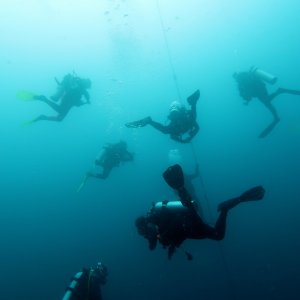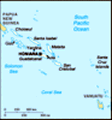Advertisement
Published: September 1st 2018

 SAFETY STOP
SAFETY STOP
Divers assume amusing positions in the water while doing the obligatory three minute safety stop before returning to the surface. Our dive computers count down the three minutes for us, if we are above twenty feet. We want to stay between fifteen and twenty feet so we must monitor and adjust our buoyancy.SOLOMON ISLANDS
LIFE ON THE LIVEABOARD
What is there to say about diving on a liveaboard? Well…we do a lot of diving. I was on the Taka for seven days and did nineteen dives. Most days four dives are scheduled. That seems like a lot, but diving on a liveaboard is easier because your dive gear is always set up. Each diver has an assigned tank secured to the bench and it is filled between dives by a long air hose attached to the compressor. We each have our own dive station and our loose gear, fins, mask, booties, etc. are in a bin under the bench below our tank. Because we were doing so many dives each day we were all using Nitrox, which is a mix of air and oxygen and means you don’t accumulate as much nitrogen during each dive. It is safer for repetative dives and supposedly energizing. Often Nitrox is called Geezer Gas in the states because of the energy boost. Since there were five of us women in the late fifties or middle sixties age bracket this was a plus. I think we had twelve divers aboard, and only three were guys. It

 SKELETON OF A GHOST ENGINE
SKELETON OF A GHOST ENGINE
I can't remember if this was an American plane or a Japanese fighter. Even after all these years some parts are easily recognizable.was an interesting mix.
If we were diving a wreck the divemaster, Adam, would give us a brief history lesson on World War II activities in the area and identify whether the wreck was Allied or Japanese. His briefing was so informative. The wrecks themselves have been in the water for seventy years or so and were completely encrusted in corals and because of sheer size, I found them difficult to photograph, but the sea life on them was prolific.
Sometimes we got into inflatable boats to get to the dive site against a wall or in a bay. Sometimes we just did a giant stride into the water, meaning we held our loose equipment that might smack us in the head or face when we hit the water, and stepped off the side of the boat. This kind of entry is pretty common but always makes me feel a little macho. After the dive we swam up to a ladder at the back of the boat, handed our fins, weights, and sometimes our tanks, to a crew member, before climbing aboard.
Coming back from a wall one night in the dark we hung onto ropes draped

 SNOOPING
SNOOPING
Rather narrow room inside a ship wreck. It can get crowded.on the side of the zodiac and were being towed back to the ladder on the Taka. All of a sudden things were jumping eight or more inches above the surface, hitting us in the face. Our dive master began laughing maniacally and I wondered what was going on? We were going through a school of little tiny flying fish, so thick you could hardly see the person next to you. When we got out of the water a few fish were still clinging to our suits. They were three or four inches long.
On the dive deck there were six bathrooms, each with a toilet and a shower. We could rinse off after every dive, then hang up our suits, dry our feet and go into the saloon where we ate. There were four meals a day plus snacks. Before our first dive we had a prelude to breakfast…toast, rolls, dry cereal, fruit and coffee, tea and water. After the first dive we had a big breakfast including some local Melanesian food and eggs, meat, fruit, and sometimes sweet rolls or pancakes. The next two dives were followed by snacks, and lunch. Dinner was usually followed by a

 CROCODILE FISH CAMOUFLAGE
CROCODILE FISH CAMOUFLAGE
It is easy to miss this guy even though he is quite large.night dive.
I did one dusk dive and one night dive, but it is difficult to manage a camera, a dive light, read the gauges underwater and keep track of your dive buddy, so I often decided to forgo the night dive. Some critters come out at night only and some of the fish sleep then, so many people love night dives. One night I chose not to go on the night dive. I was sitting in on the briefing however. Adam showed a photo of a crocodile, a resident of this particular dive site, and then said not to worry because one of the staff would be sitting on the bridge with a rifle to scare off the crocodile if he splashed in. I was glad I had already cancelled the dive. I am not sure what is most terrifying…bullets streaking through the water, or meeting a crocodile in the dark.
Some of the women gathered together between dives to identify and catalogue nudibranchs (sea slugs, hundreds of different colors and shapes) and other sea creatures. With all the diving and camera preparation the days passed quickly.
On our last day while our gear dried, we

 HEALTHY CORAL
HEALTHY CORAL
This rose shaped coral is deep enough that there is no bleaching.took an excursion to a tribal village where there was music and dancing and laughter, sometimes at our expense. The village was very clean, the costumes were colorful and the children adorable.
Three ladies had flights the same time as I did, so we shared a cab to the airport and enjoyed some “getting to know you” time without the entire focus of the conversation on diving.
I will be in Vanuatu in two and a half hours, my last dive destination for this trip. As I wrote in my journal, I was “crying tired.”
Advertisement
Tot: 0.389s; Tpl: 0.012s; cc: 26; qc: 116; dbt: 0.1541s; 1; m:domysql w:travelblog (10.17.0.13); sld: 1;
; mem: 1.3mb















D MJ Binkley
Dave and Merry Jo Binkley
Liveaboard Experience
I've been diving since the late 80s and have never done a live aboard. You know the one strange guy at the dive resort or the dive boat that annoys everyone? I'm always afraid of getting stuck for a week on a live aboard with one of those guys. What has been your experience? Your photos are always so outstanding. Thanks for taking us along.